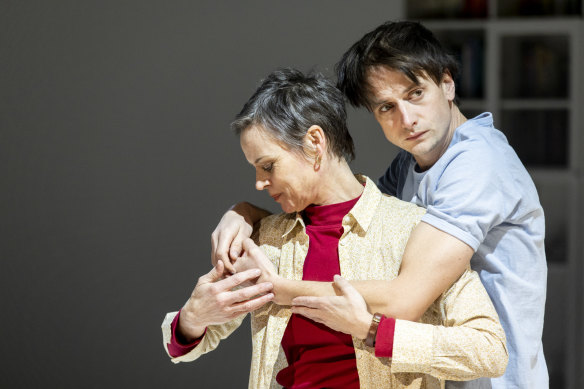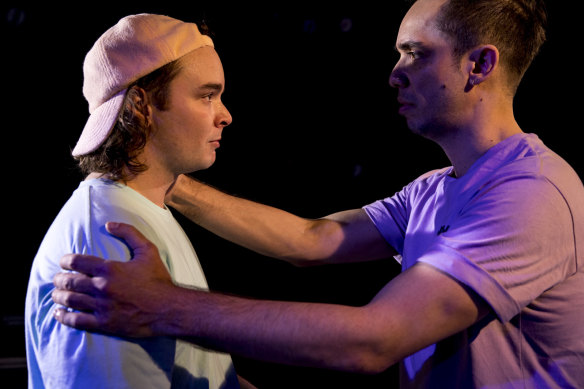Love conquers all in this diverse musical offering
A Midsummer Night’s Dream with Simone Young
Sydney Symphony Orchestra
Opera House Concert Hall
August 26
Also August 27, 2pm and 7pm
★★★★½
This was a dream of magical lightness and delight – not so much music to accompany Shakespeare’s play, as an enchanting pantomime created by director Eamon Flack and seven Belvoir St Theatre players to accompany a complete performance by Simone Young and the Sydney Symphony Orchestra of Mendelssohn’s score rather than just the well-known numbers.
The overture began conventionally enough though impeccably tuned, with the familiar pair of quiet flute notes, opening out like morning light as clarinets, horns and bassoon joined. But at the point of recapitulation, just as one had settled into concert-style listening, free from extraneous association except that provided by the inner recesses of the imagination, a large purple flower emerged near the ophicleide (that splendid precursor to the tuba that trombonist Nick Byrne produces for Mendelssohn and Berlioz, to capture the composer’s original sound).
At first, the flower was a distraction, like a playful child when you are reading, but sensing that was the way it was going to be, the only option was to close the interior concert playbook, and embrace the game. Lovers (Sarah Meacham, Rose Riley, Jack Scott and George Zhao who doubled as the mechanicals) mimed kisses and quarrels, while Theseus and Hippolyta (Tim Walter and Brigid Zengeni who later play Oberon and Titania) prepared for their midsummer marriage.
By the time one reached Young’s crisply articulated, bristlingly precise performance of the Scherzo, one was spirited away from the brilliant acoustic translucence of the newly refurbished concert hall to a capricious between-world where both theatre and music badger you away when you are starting to pay too much attention to the other.
Simple as that sounds, these combinations of theatre and music are not easy to bring off. What made this work was that Mendelssohn rather than Shakespeare was allowed to lead the narrative, while Flack elegantly compressed the plot’s complexities with silent enactment, not forgetting the beauty of Shakespeare’s own rhythm and cadence in key lines.
Flack and associate director Hannah Goodwin had twists of their own, replacing Titania’s humiliation with Oberon’s, which seems fitting given it is his entitlement that starts their quarrel. Damien Cooper and Lisa Mimmochi provided, respectively, discreet but effective lighting and costumes.
Soprano Samantha Clarke sang the fairy spell, “you spotted snakes” with a beautifully mellifluous voice of smooth brightness, while mezzo Anna Dowsley added a wonderfully rich intensity like sun-warmed marble. The elite choir of female voices, Cantillation, created crisp coloured and brilliantly alert textures.
The musical high point was the beautiful Nocturne where horn and bassoon gleamed like rays of soft moonlight. Virginia Gay, as a quintessentially Australian Puck – teasing, provoking, irreverent and warm – had the last word at which the audience gave not just their hands but a standing ovation.
– Peter McCallum
MEREMERE
Studio, Sydney Opera House, August 25
Also, August 26 and 27
★★★★
Reading about Rodney Bell Ngati Maniapoto dancing in his wheelchair is one thing. Seeing him do it is something else.
Although an accident took away the use of his legs, his movement goes beyond the strong and graceful gestures of his upper body.
He has bonded with the wheels in such a way that his fast-moving action is truly dancing. The way he manipulates that chair – leaning into curves, bending forward to head into a startling stage-edge stop – is extraordinary.

In one poignant moment an empty chair was transformed to seem almost human.Credit:Joseph Mayers
He can also be gentle. In my favourite sequence, he dances with an empty wheelchair as though it is a female partner in the usual manner of theatre dance. In that poignant moment, the chair was transformed: it seemed almost human.
Rodney Bell also danced with a young woman he introduced as Estelle in a bold duet that gave both of them impressive opportunities, singly and together, in some essentially inventive partnering.
And he finished with a demanding solo that used every centimetre of the stage-within-a-stage that allows occasional video to extend the dance.
There is also a variety of music in what is essentially an autobiographical piece about a life that has lurched from homelessness to high achievement. Told engagingly in Bell’s words as well as movement, it is both amusing and painful.
A long opening solo of what I assume is Maori storytelling – a moving performance by an Elder – establishes Bell’s background. Bell himself sings and plays harmonica. And a guitarist does a sterling job of colouring in the movement and words, along with some recorded music.
The show lasts only an hour but the experience is so wide-ranging and rich that it seems longer.
– Jill Sykes
A cultural guide to going out and loving your city. Sign up to our Culture Fix newsletter here.
TELL ME I’M HERE
Belvoir St Theatre, August 24
Until September 25
★★★★
Suddenly, it congeals. We are well into Act Two when Jonathan re-enters with a neck spasm, and that excruciating movement instantly conveys all the piteousness of his plight. Having sympathised with Jonathan from the start, now we empathise, and the emotional connection is real, raw and deeply affecting. If Tom Conroy’s portrayal of Jonathan had been good all along, now it was exceptional.

Nadine Garner and Tom Conroy in Tell Me I’m here.Credit:Brett Boardman
It’s a role that could so easily be overcooked; become what another character refers to as “an allegory of horror”. Jonathan suffers from schizophrenia, and the terrors his condition holds for him must be brought to life, alongside the sorrow and exasperation it holds for those around him – especially his mother, Anne (Nadine Garner). Her capacity for love, patience and forgiveness is tested to an extreme few parents ever know.
Anne is the late Anne Deveson, the renowned writer, broadcaster and documentary film-maker, who detailed her oldest child’s crucifying illness in her brave, compelling and moving memoir Tell Me I’m Here, first published in 1991. This was a major work illuminating the nature of the malady, the inadequacy of the health sector’s response, and the fearful ignorance of some quacks and of the community at large.
Now Veronica Nadine Gleeson has adapted this into a play, directed by Leticia Caceres. While it is capable of being heartrending and funny, somehow it too seldom achieves the book’s blinding intensity. Until that Act Two moment of brilliance from Conroy, I’d wondered whether this lack of intensity lay in the performances. No. I suspect Gleeson has been too reverential to the book’s linear form – for the good reason that it’s true! Yet perhaps a deeper truth of the book was within reach had the piecemeal nature of such a multiplicity of scenes been forsaken in favour of some longer ones that were allowed to build.
Loading
If Conroy’s role is a challenge because it would be easy to overdo, Garner’s role is so for the opposite reason. In her ideal world, Anne would keep everything on a tight leash, but Jonathan is the eternal stray who can’t be trained. Garner has to draw our sympathy while playing the stoic who resents that her wayward son can make her lose control of her neatly compartmentalised emotions. It’s a tricky balancing act, and one Garner may master yet more thoroughly as she feels out her audiences.
Caceres has done a fine job of casting the piece, with Sean O’Shea shining as two of Anne’s partners and assorted other roles including a Mohawk-haired punk. Deborah Galanos, Raj LaBade and Jana Zvedeniuk complete the strong cast.
Choreographer Charmene Yap has apparently played a key role in helping Conroy develop Jonathan’s physicality, while set designer Stephen Curtis has made the white-box, book-lined space all Anne’s, within which he and Caceres allow Conroy to express Jonathan’s psychosis through drawing – essentially graffitiing the set.
Anne is a marvellous contrast to Jonathan because she’s so crisp and articulate, while also being the progenitor of his flashes of wit and laughably formal politeness. Then there are key moments when Anne is rendered speechless and Jonathan becomes lucid, making such observations as, “I’m actually fine. Everyone else is sick” – which carries considerable perspicacity in relation to some medical decision-makers. Another time he asks, “Do you think anything is wrong with my heart? I think it’s broken.” It was. He was dead at 24 – “an instrument too fine-tuned to bear the vicissitudes of life”.
– John Shand
A cultural guide to going out and loving your city. Sign up to our Culture Fix newsletter here.
Whitefella Yella Tree
SBW Stables Theatre/Griffin Theatre Co
August 24
Until September 23
★★★★
Two boys, 15 and achingly alive, meet under a lemon tree. Ty (Callan Purcell) is River Mob, Neddy (Guy Simon) is Mountain Mob, and when they meet, talking turns to romance.
They gush about each other to their families. It’s funny, sweet. Magical.

Callan Purcell and Guy Simon in this funny, sweet, magical queer love story.Credit:Brett Boardman
It’s also devastating. It’s the early 1800s, and Ty and Neddy meet for the first time on behalf of their Elders to exchange information about new white settlers invading their land.
Whitefella Yella Tree is a queer love story of eruptions and disruptions, but the queerness isn’t the problem; it’s weaponised colonisation, in all its ugliness, that threatens rupture. In Ty and Neddy’s world, their romance is be celebrated. But white settlement is hell-bent on destroying that world.
As they continue to meet, and grow into men, can their precious, heart-opening queer love survive Australia’s brutal colonisation?
Dylan Van Den Berg is early in his career but has already won several playwriting awards. It’s easy to see why. He has a shrewd ear for dialogue, writing lively and lovely scenes for Ty and Neddy that contain a clear internal compass pointing ever-forward: as the stakes get higher and their reality becomes more fraught, we feel it deeply.
Loading
This is a play crafted with nuance and care, and co-directors Declan Greene and Amy Sole amplify its multitudes. They don’t flinch away from moments of devastation, but they let us linger in lightness, too, when it comes; joy and heartbreak are given equal weight.
On Mason Browne’s open-sky design, where branches grow out of the ceiling (a gesture towards that lemon tree), the actors create something impossibly tender that still bites with gloriously lived-in detail. As they fall in love with each other, we fall in love with them.
Their meeting place is embraced by Kelsey Lee’s lights, which always seem to find the heartbeat of a scene and illuminate it. The world of the play extends beyond the horizon and into the gut thanks, in part, to Steve Toulmin’s composition and sound design: it warns us of danger and carries us through time.
Whitefella Yella Tree carries pain, weeping from still-fresh loss, but it isn’t weighted down; it doesn’t sink. Instead, it’s a tight embrace holding fast to culture, stories and beliefs. It’s a hand holding yours in solidarity. It’s speaking old knowledge into living, breathing, life. It’s an act of survival. It’s an expression of love. It soars.
– Cassie Tongue
A cultural guide to going out and loving your city. Sign up to our Culture Fix newsletter here.
Share this news on your Fb,Twitter and Whatsapp
Times News Network:Latest News Headlines
Times News Network||Health||New York||USA News||Technology||World News